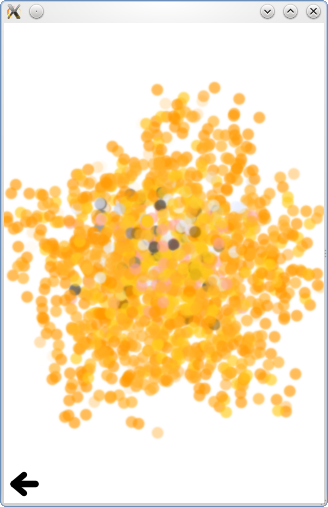
This is a collection of examples using CustomParticle in the QML particle system.

This is a collection of small QML examples relating to using CustomParticle in the particle system. Each example is a small QML file emphasizing a different way to use CustomParticle.
Blur Particles adds a blur effect to the particles, which increases over the particle's life time. It uses a custom vertex shader:
vertexShader:" uniform lowp float qt_Opacity; varying lowp float fFade; varying lowp float fBlur; void main() { defaultMain(); highp float t = (qt_Timestamp - qt_ParticleData.x) / qt_ParticleData.y; highp float fadeIn = min(t * 10., 1.); highp float fadeOut = 1. - max(0., min((t - 0.75) * 4., 1.)); fFade = fadeIn * fadeOut * qt_Opacity; fBlur = max(0.2 * t, t * qt_ParticleR); } "
to propagate life time simulation to a custom fragment shader:
fragmentShader: " uniform sampler2D source; uniform sampler2D blurred; varying highp vec2 qt_TexCoord0; varying highp float fBlur; varying highp float fFade; void main() { gl_FragColor = mix(texture2D(source, qt_TexCoord0), texture2D(blurred, qt_TexCoord0), min(1.0,fBlur*3.0)) * fFade; }"
which has access to both the normal image sampler and a blurred sampler, the image plus a ShaderEffect.
Fragment Shader just uses the particle system as a vertex delivery system.
fragmentShader: " varying highp vec2 fPos; varying lowp float fFade; varying highp vec2 qt_TexCoord0; void main() {//*2 because this generates dark colors mostly highp vec2 circlePos = qt_TexCoord0*2.0 - vec2(1.0,1.0); highp float dist = length(circlePos); highp float circleFactor = max(min(1.0 - dist, 1.0), 0.0); gl_FragColor = vec4(fPos.x*2.0 - fPos.y, fPos.y*2.0 - fPos.x, fPos.x*fPos.y*2.0, 0.0) * circleFactor * fFade; }"
Image Colors uses CustomParticle to assign colors to particles based on their location in a picture. The vertex shader,
vertexShader:" uniform highp float maxWidth; uniform highp float maxHeight; varying highp vec2 fTex2; varying lowp float fFade; uniform lowp float qt_Opacity; void main() { fTex2 = vec2(qt_ParticlePos.x, qt_ParticlePos.y); //Uncomment this next line for each particle to use full texture, instead of the solid color at the center of the particle. //fTex2 = fTex2 + ((- qt_ParticleData.z / 2. + qt_ParticleData.z) * qt_ParticleTex); //Adjusts size so it's like a chunk of image. fTex2 = fTex2 / vec2(maxWidth, maxHeight); highp float t = (qt_Timestamp - qt_ParticleData.x) / qt_ParticleData.y; fFade = min(t*4., (1.-t*t)*.75) * qt_Opacity; defaultMain(); } "
passes along the starting position for each vertex to the fragment shader,
fragmentShader: " uniform sampler2D particleTexture; uniform sampler2D pictureTexture; varying highp vec2 qt_TexCoord0; varying highp vec2 fTex2; varying lowp float fFade; void main() { gl_FragColor = texture2D(pictureTexture, fTex2) * texture2D(particleTexture, qt_TexCoord0).w * fFade; }"
which uses it to determine the color for that particle.
Files:

As part of the free Business evaluation, we offer a free welcome call for companies, to talk about your requirements, and how the Felgo SDK & Services can help you. Just sign up and schedule your call.
Sign up now to start your free Business evaluation:

